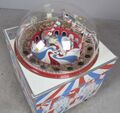Difference between revisions of "Jumbo"
From Sega Retro
Tag: Undo |
|||
| Line 16: | Line 16: | ||
The object of the game is to pick up the ball with the elephant's trunk (suction), then point the trunk towards the ceiling. A blower motor kicks in to elevate the ball above the trunk, with a moving metal habitrail in front of the trunk. Time and release the ball, and it falls through the habitrail (hopefully) into a scoring hole around the parameter of Jumbo. The ball rolls back to the elephant to try again. | The object of the game is to pick up the ball with the elephant's trunk (suction), then point the trunk towards the ceiling. A blower motor kicks in to elevate the ball above the trunk, with a moving metal habitrail in front of the trunk. Time and release the ball, and it falls through the habitrail (hopefully) into a scoring hole around the parameter of Jumbo. The ball rolls back to the elephant to try again. | ||
| − | Electronic circus music is played from tape via an 8-track player. It was the electronic game to feature the use of music.{{ref|1=https://www.youtube.com/watch?v=ZlJZfqp0NbQ}} | + | Electronic circus music is played from tape via an 8-track player. It was the electronic game to feature the use of music.{{ref|1=https://www.youtube.com/watch?v=ZlJZfqp0NbQ}} ''[[MotoPolo]]'' (1968) previously used an 8-track player to playback recorded sounds, which ''Jumbo'' took a step further to playback music. The game's cabinet was later used for ''[[Dan-Bo]]'' (1973), while the music system was later used for ''[[Sand Buggy]]'' (1972). |
==Gameplay== | ==Gameplay== | ||
Latest revision as of 13:37, 12 December 2024

| |||||||||||||
| Jumbo | |||||||||||||
|---|---|---|---|---|---|---|---|---|---|---|---|---|---|
| System(s): Electro-mechanical arcade | |||||||||||||
| Publisher: Sega Enterprises, Ltd. | |||||||||||||
| Developer: Sega Enterprises, Ltd. | |||||||||||||
| Number of players: 1 | |||||||||||||
|
This short article is in need of work. You can help Sega Retro by adding to it.
Jumbo is a 1969 electro-mechanical arcade game manufactured by Sega Enterprises, Ltd.
The object of the game is to pick up the ball with the elephant's trunk (suction), then point the trunk towards the ceiling. A blower motor kicks in to elevate the ball above the trunk, with a moving metal habitrail in front of the trunk. Time and release the ball, and it falls through the habitrail (hopefully) into a scoring hole around the parameter of Jumbo. The ball rolls back to the elephant to try again.
Electronic circus music is played from tape via an 8-track player. It was the electronic game to feature the use of music.[4] MotoPolo (1968) previously used an 8-track player to playback recorded sounds, which Jumbo took a step further to playback music. The game's cabinet was later used for Dan-Bo (1973), while the music system was later used for Sand Buggy (1972).
Contents
Gameplay
Specifications
Dimensions






